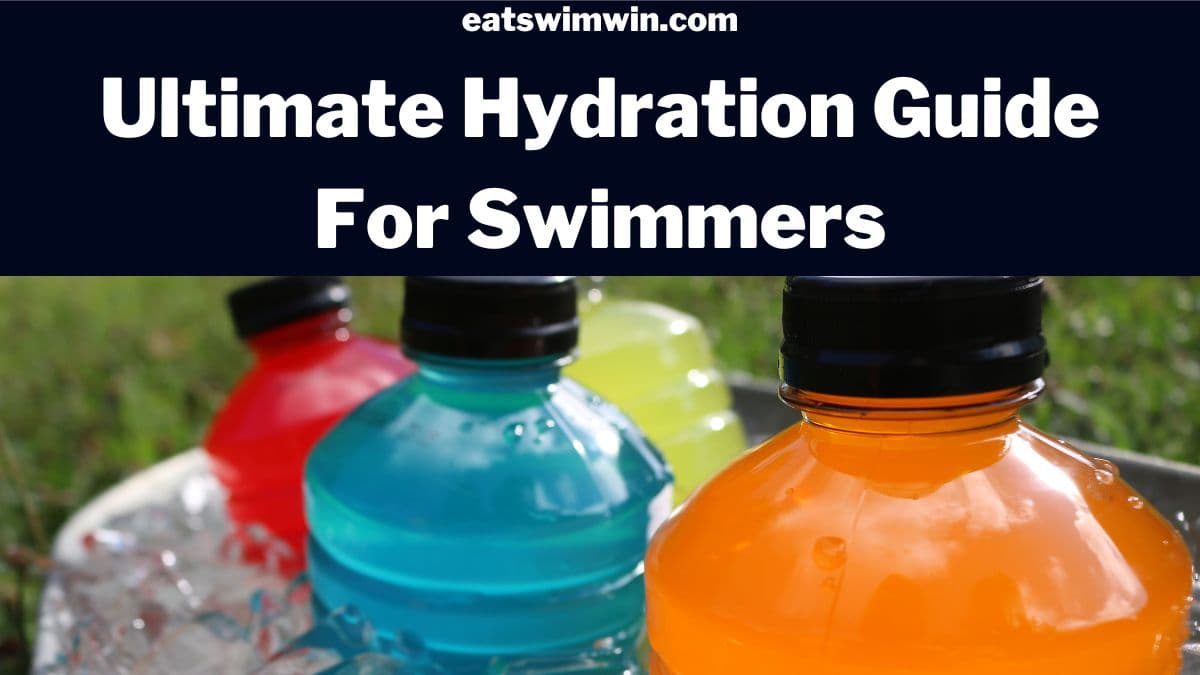Are you a swimmer struggling to stay hydrated during practice? With the unique challenges of the sport, it’s crucial to maintain proper hydration to optimize performance.
Did you know that swimmers often feel less thirsty in the water, making it even more important to proactively drink fluids? Waiting until you feel thirsty means you may already be dehydrated.
To help you stay on top of your hydration game, we’ve put together a comprehensive guide to hydrate swimmers with tips and tricks to help you check your hydration status, determine how much fluids to consume, choose the right sports drink, replenish your electrolytes, conduct a sweat test, and even discover hydrating foods.
Don’t let dehydration hold you back in the pool – keep reading to learn more!

Table of Contents
What is dehydration?
Dehydration happens when an athlete is losing more fluids than they are consuming. This can have a significant detrimental impact on physical performance.
When an athlete is dehydrated, they have a decreased blood volume, so less oxygen is brought to the muscles.
Dehydration can also cause:
- Cramps
- Increase heart rate
- Decreased blood pressure
- Fatigue
- Headache
- Dizziness
- Dry mouth
Am I dehydrated?
An athlete can monitor hydration status with and without a dietitian in several ways. However, if you are experiencing severe symptoms, we recommend seeking medical attention.
Check out five ways you can monitor your hydration status as a swimmer.
Check your urine
Swimmers can check on their hydration status every day by looking at their urine color. Aim for lemonade-like yellow urine versus apple juice-colored urine.
Keep in mind that multivitamins can cause dark urine!
Skin turgor
One simple and quick way to check your hydration status is by performing the skin pinch test.
To do this test, simply pinch the skin on the back of your hand between your thumb and forefinger and then release. If the skin immediately returns to its normal position, you may be well-hydrated.
However, if it takes longer for the skin to return to its normal position, it may indicate dehydration.
It’s important to note that the skin pinch test can vary depending on factors such as age and skin elasticity. However, it can still be a useful tool to quickly assess your hydration status
Heart rate
If you wear a device such as an Apple watch or Garmin watch, check your heart rate! If your heart rate is higher than your typical resting heart rate, this can be an indication of dehydration.
However, many factors can also impact heart rate such as stress and exercise so heart rate alone is not the best assessment of hydration status.
Thirst
Feeling thirsty can begin when an athlete is 1-2% dehydrated. Do not wait till you are thirsty to drink!
Feeling thirsty can be a sign that a swimmer is already dehydrated.
Urine-specific gravity and osmolality
Urine-specific gravity measures the concentration of solutes in the urine.
When a swimmer is dehydrated, their kidneys hold on to water and produce more concentrated urine. This urine has a higher specific gravity and osmolality.
Athletes can use urine dipsticks (available at many drug stores) at home to check urine-specific gravity and osmolality, but these results can vary in accuracy.
When testing urine specific gravity >1.020 g/mL and a urine osmolality >800 mOsm/kg can indicate dehydration.
Hydration for swimmers
How much fluids a swimmer needs can vary greatly depending on their sweat rate! A swimmer’s sweat rate can vary greatly depending on elevation, humidity, intensity or workout heat acclimation, and more!
Check out our Sweat Rate Calculator to calculate how much fluid you need!
A general rule guideline for athletes is to consume ½ – 1 fluid ounce per pound of body weight.
For a 150lb athlete, this is 75 – 150 oz per day.
How much hydration before, during, and after swimming?

2-3 hours before training: 16- 24 oz (2-3 c) of fluid
30 minutes before training: 8oz (1 cup) of fluid
Every 15-30 minutes: sips- 4oz (½ c) of fluid
After training: 16oz (2 cups) of fluid for each pound lost
Should swimmers drink sports drinks?
For workouts over 60 minutes, we recommend athletes consume electrolytes! Because when you sweat, you don’t just lose fluid! You also lose electrolytes including sodium, chloride, potassium, calcium, and magnesium.
Too much plain water without electrolytes can increase the risk of low blood sodium levels, also known as hyponatremia.
Hyponatremia can lead to muscle cramps, confusion, fatigue, and seizures.
Sweat testing for swimmers
Some swimmers are saltier sweaters than others! We recommend completing a sweat test patch to test how salty of a sweater you are.
This helps to identify what type of sports drink or electrolytes you may need.
While these patches are not perfect, they can serve as a guide to start from!
Sweat test patch
Gatorade Gx Sweat Patch: These sweat patches are a more affordable way to check how much sodium you may need during endurance activities and long practices.
Sweat patches aren’t a perfect method for swimmers since you cannot wear the patch in the water! But if you can do 60 minutes of dryland, running, or biking it can give you a rough estimate of your salt losses.
Often the sweat tests can result in higher than-needed sodium recommendations. We recommend using these results as a range to start from.
We recommend connecting with a sports dietitian for more personalized assistance!
Check out our video on How to Use a GX Sweat Patch to learn more.
Am I a salty sweater?
Don’t have the time or money to spend on a sweat test patch?
Look for these signs to see if you are a salty sweater:
- Dried salt on your body after dryland workouts
- Salty stinging eyes
- Sweat tastes salty
- Salt-stained clothes after dryland exercises
What to look for in a sports drink
What you need in a sports drink can vary greatly depending on how long your workout is and how salty of a sweater you are.
At a minimum, we recommend sports drinks with carbohydrates, sodium, and potassium.

Aim for 12-18 g of carbohydrate per 8oz, 110-170 mg of sodium per 8oz, and 20-50 mg of potassium per 8oz.
Check out our blog post on Gatorade vs vitaminwater to learn more.
Foods to help hydrate swimmers
Are you tired of drinking plain water? Here are other foods that can help you increase how much fluid you consume!
Hydrating foods:
- Soup
- Jello
- Ice pops
- Smoothies
- Coconut water
- Yogurt
- Fruits
- Vegetables
Keep reading to learn more about the most hydrating fruits and vegetables.
Hydrating fruits
Fruits rich in fluids to help prevent dehydration include:
- Watermelon
- Strawberries
- Cantaloupe
- Pineapple
- Oranges
- Peaches
Hydrating vegetables
Vegetables that can increase your hydration status and add fiber to your diet include:
- Cucumber
- Lettuce
- Celery
- Zucchini
- Bell peppers
How to stay hydrated
If you are having a difficult time drinking enough throughout the day, we recommend:
- Incorporate foods rich in fluids
- Use a hydration reminder app or set timers to remind yourself to drink
- Carry a water bottle with you
Conclusion
Dehydration can make or break your performance in competition or in practice!
5 important takeaways for swimmers’ hydration are:
- Calculate your sweat rate
- Consume enough fluids throughout the day
- Drink enough before, during, and after your workout
- Replenish with electrolytes as needed
- Hydrate with fluid-rich foods!
Keep an eye out for signs of dehydration to optimize your performance!
Other posts you may like
The Best Supplements For Swimmers
6 Foods To Avoid Before Swimming
The Best Open Water Swimming Nutrtion Guide
What to Eat Before Swim Practice (20 pre-swim snack ideas!)

Katie Schimmelpfenning RD, LD is a Registered Dietitian Nutritionist, USA Swim Coach, and former Division 1 swimmer. She helps competitive swimmers fuel and train to optimize performance, recover faster, and prevent injury! She is passionate about spreading evidence-based nutrtion tips to help swimmers across the globe.
